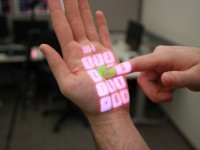This forward-looking technology report explores OmniTouch, a game-changing wearable projection system developed by Chris Harrison, a Carnegie Mellon Ph.D. student and Microsoft researcher, that transformed any surface into an interactive touchscreen interface. Patrick Bisch examines this latest research project that seemed to bring science fiction concepts from Minority Report into tangible reality, showcasing how academic research was pushing the boundaries of human-computer interaction in ways that felt genuinely futuristic.
The technical addation combined a Microvision ShowWX+ pico-projector with a PrimeSense depth camera, worn as a shoulder-mounted device that could project interactive interfaces onto walls, tables, or even the user's own arm. The system's sophisticated depth sensing features allowed for precise multi-finger input detection across X, Y, and Z axes, enabling complex gesture-based interactions with projected content. Bisch provides context by connecting this innovation to Pranav Mistry's earlier SixthSense technology from 2009, noting how OmniTouch represented an evolution of Microsoft Research's ongoing exploration into ambient computing interfaces.
The article captures the excitement and potential of augmented reality research at a time when such concepts were still largely confined to academic laboratories and science fiction. The author acknowledges that while consumer adoption would likely take years, the very existence of such technology showd how rapidly the boundaries between digital and physical interaction were dissolving, pointing toward a future where computing interfaces could exist anywhere.
This report documents a pivotal moment in augmented reality and wearable computing research that directly influenced the development of technologies we see today. Looking back 13+ years later, OmniTouch's vision has partially materialized through products like Microsoft HoloLens, Magic Leap headsets, and advanced AR smartphone applications, though the specific shoulder-mounted projection approach never gained commercial traction. The research represented early exploration into what would become modern mixed reality and spatial computing, predating widespread adoption of AR by over a decade. While OmniTouch itself remained a research prototype, its concepts about surface-agnostic interaction and gesture-based computing influenced the development of voice assistants, smart displays, and touch-free interfaces that became essential during the COVID-19 pandemic. The post showcases how academic research in human-computer interaction was already envisioning the ambient computing future that companies like Apple, Google, and Meta are now actively pursuing with their spatial computing platforms.
This summary was created by Dave Rogers. The original post was written by Patrick Bisch and published on October 1, 2011.
If you'd like to view the original post, you can find it here.
